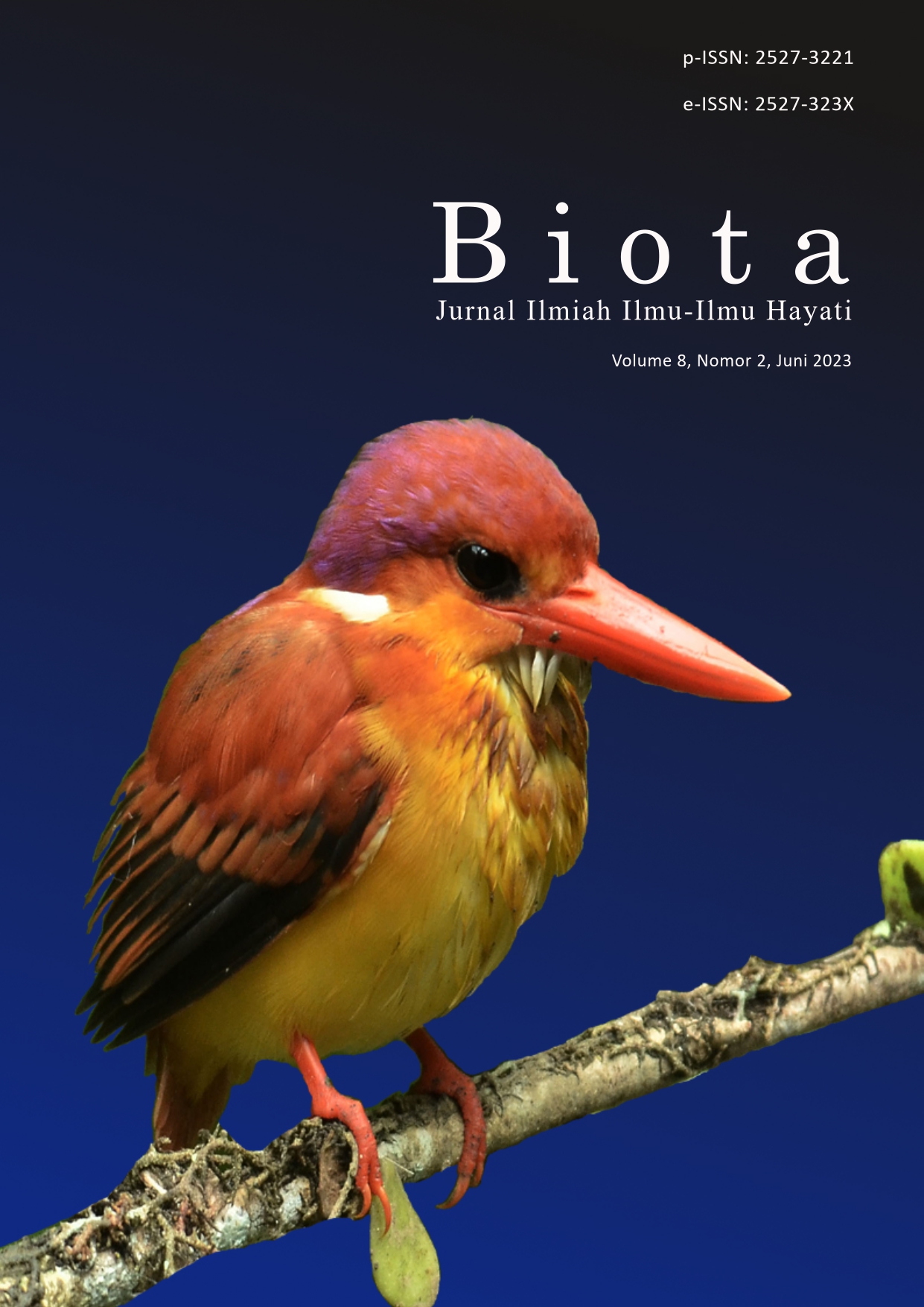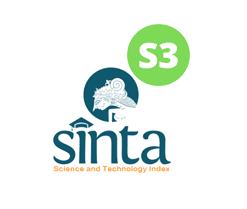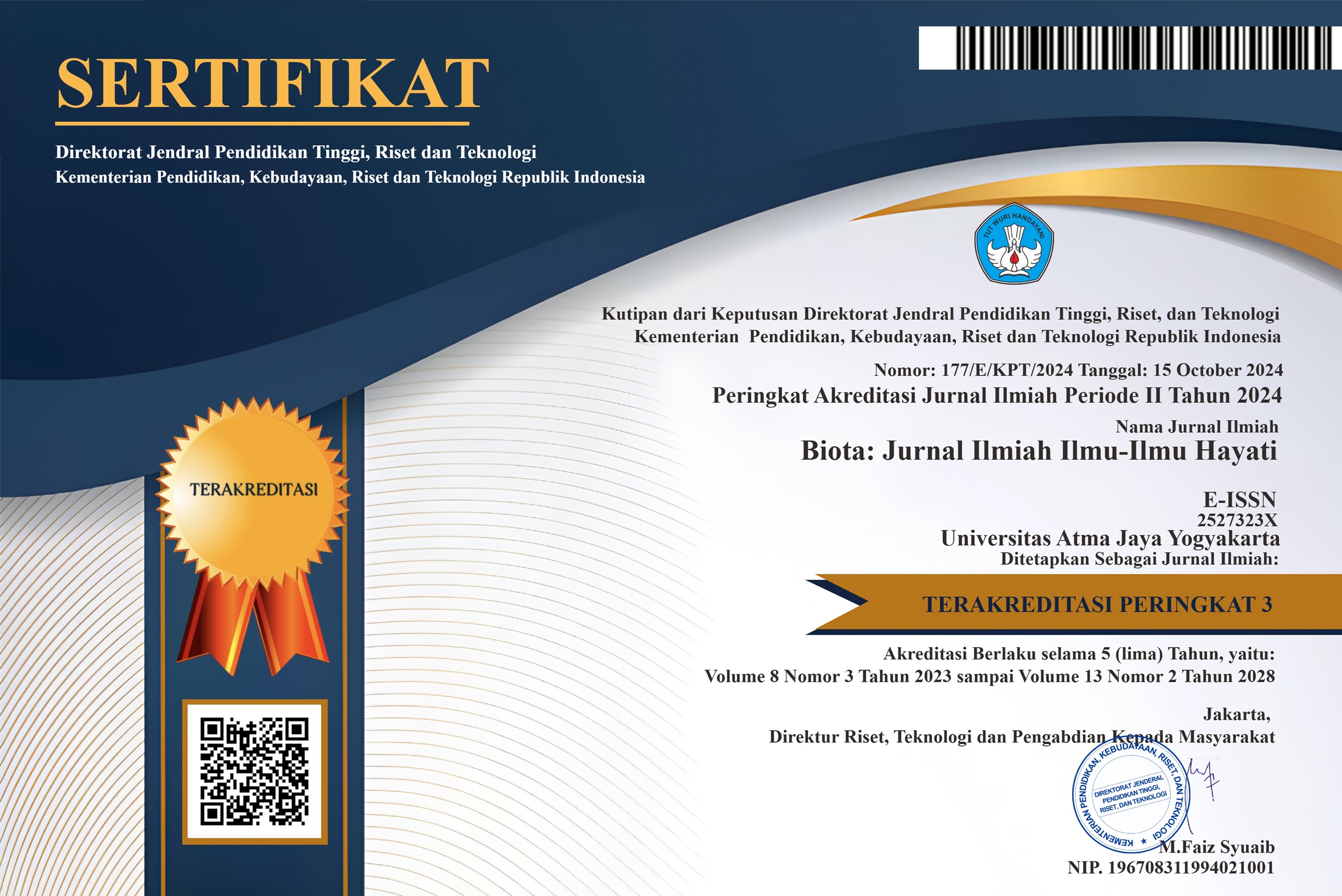Potensi Bacillus spp. Sebagai Penghasil Biosurfaktan untuk Pengolahan Limbah Minyak Pelumas
DOI:
https://doi.org/10.24002/biota.v8i2.6360Keywords:
Bacillus spp., biosurfaktan, emulsifikasi, lipopeptida, minyak pelumasAbstract
Biosurfaktan adalah makromolekul ekstraseluler yang dihasilkan oleh mikroorganisme yang memiliki sifat ramah lingkungan serta memiliki berbagai fungsi salah satunya untuk emulsifikasi limbah minyak. Penelitian ini bertujuan mengetahui potensi isolat Bacillus spp. dalam menghasilkan senyawa biosurfaktan untuk pengolahan limbah minyak pelumas. Metode yang digunakan adalah penetapan indeks emulsifikasi dan analisis aktivitas emulsifikasi (drop collapse test, oil spreading technique, uji tegangan muka) dari supernatan kultur Bacillus spp., serta karakterisasi biosurfaktan dengan Kromatografi Lapis Tipis (KLT). Supernatan dari ketiga isolat Bacillus spp. menunjukkan hasil positif dengan uji drop collapse test dan oil spreading technique dengan diameter zona bening tertinggi diperoleh dari Bacillus sp 48 sebesar 10,2 mm, serta nilai indeks emulsifikasi (E24) sebesar 99,5%. Berdasarkan hasil KLT diketahui bahwa biosurfaktan yang dihasilkan oleh ketiga isolat bakteri Bacillus spp. adalah golongan lipopeptida. Bacillus spp. yang dapat menurunkan tegangan permukaan dari minyak pelumas adalah Bacillus sp 48 yaitu sebesar 19,7 dyne/cm, Bacillus sp 34 sebesar 17,9 dyne/cm dan Bacillus sp 84 sebesar 15,7 dyne/cm. Biosurfaktan dari ketiga isolat Bacillus spp. berpotensi dikembangkan dalam berbagai bidang industri.
References
Adu, S. A., Naughton, P. J., Roger Marchant, R. & Banat, I. M. (2020). Microbial Biosurfactants in Cosmetic and Personal Skincare Pharmaceutical Formulations. Pharmaceutics 12(11): 1099-1120.
Ali, N., Pang, Z., Wang, F., Xu, & El-Seedi, H. R. (2022). Lipopeptide Biosurfactants from Bacillusspp.: Types, Production, Biological Activities, and Applications in Food. Hindawi Journal of Food Quality 2022: 1-19.
Bukhori, A., Suryanto D., & Nurtjahja, K. (2022). Biosurfactant activity of phylloplane bacteria from an ornamental plant, Colocasia esculenta L. Biodiversitas Journal of Biological Diversity 23(6): 3108-3114.
Chakrabortya, S., Ghosha, M., Chakraborti, S., Janaa, S., Sena, K. K., Kokare, C., & Zhangc, L. (2015). Biosurfactant produced from Actinomycetes nocardiopsis A17: Characterization and its biological evaluation. International Journal of Biological Macromolecules. 79: 405-412.
Ciccyliona & Nawfa R. (2012). Pengaruh pH terhadap produksi biosurfaktan oleh bakteri Pseudomonas aeruginosa lokal. Jurnal Sains dan Pomits 1(1): 1-6.
Citra, S. & Nurhasanah. (2021). Skrining bakteri penghasil biosurfaktan dari air laut tercemar minyak di pelabuhan panjang lampung. Rafflesia Journal of Natural and Applied Sciences 1(1): 50-58.
Das, P., Mukherjee, S. & Sen, R. (2008). Antimicrobial potential of a lipopeptide biosurfactant derived from a marine Bacillus circulans. Journal of applied microbiology 104(6): 1675-1684.
Deng, Z., Jiang, Y., Chen, K., Li, J., Zheng, C., Gao, F., Liu, X. 2020. One Biosurfactant-Producing Bacteria Achromobacter sp. A-8 and its potential use in microbial enhanced oil recovery and bioremediation. Front. Microbiol 11: 247.
Desai, J. D. & Banat, I. M. (1997). Microbial production of surfactants and their commercial potential. Molecular Biology 61(1): 47-64.
El-Sheshtawy, H. S., Aiad, I., Osman, M. E., Abo-ELnasr, A. A., & Kobisy, A.S. (2015). Production of biosurfactant from Bacillus licheniformis for microbial enhanced oil recovery and inhibition the growth of sulfate reducing bacteria. Egyptian Journal of Petroleum 24:155-162.
Ghazala, I., Bouassida, M., Krichen, F., Manuel Benito, J., Ellouz‐Chaabouni, S. & Haddar, A. (2017). Anionic lipopeptides from Bacillus mojavensis I4 as effective antihypertensive agents: Production, characterization, and identification. Engineering in life sciences 17(12): 1244-1253.
Kamar, I., Zahara, F., Yuniharni, D. & Umairah, R. (2021). Identifikasi parasetamol dalam jamu pegal linu menggunakan metode kromatografi lapis tipis (KLT). QUIMICA: Jurnal Kimia Sains dan Terapan 3(1): 24-29.
Kurniadie, D., Sumekar, Y., Buana, I. 2017. Pengaruh berbagai jenis surfaktan pada herbisida glufosınat terhadap pengendalian gulma dan hasıl tanaman jagung (Zea mays l.) di Jatınangor. Jurnal Kultivasi 16(2): 378- 381.
Ni’matuzahroh, N. M., Sari, S. K., Ningrum, I. P., Aprilla, D. P., Marjayandari, L., Trikurniadewi, N., Ibrahim, S. N. M. M., Fatimah, Nurhariyati, T., Surtiningsih, T. & Yuliani, H. (2019). The potential of indigenous bacteria from oil sludge for biosurfactant production using hydrolysate of agricultural waste. Biodiversitas Journal of Biological Diversity 20(5): 1375-1379.
Ningsih, M. D. S., Linda, T. M. & Fibriarti, B. L. (2018). Isolasi dan keragaman bakteri ureolitik lokal riau yang berpotensi sebagai campuran beton Al-Kauniyah 11(1): 57-63.
Nunal, S. N., Santander-De S. M. S. L., Bacolod, E., Koyama, J., Uno, S., Hidaka, M., Yoshikawa, T. & Maeda, H. (2014). Bioremediation of heavily oil-polluted seawater by a bacterial consortium immobilized in cocopeat and rice hull powder. Biocontrol Science 19(1): 11-22.
Phulpoto, I. A., Yu, Z., Hu, B., Wang, Y., Ndayisenga, F., Li, J., Liang, H. & Qazi, M. A. (2020). Production and characterization of surfactin-like biosurfactant produced by novel strain Bacillus nealsonii S2MT and it's potential for oil contaminated soil remediation. Microbial cell factories 19(1): 1-12.
Priyatno, A.N. (2015). Pengaruh penambahan konsentrasi larutan surfaktan disosiumethylenediamineteraacetic Salt (Na2EDTA) terhadap tegangan permukaan dan viskositas oli mesin pertamina enduro 4 stroke [Tesis]. Universitas Negeri Yogyakarta.
Reningtyas, R. & Mahreni, M. (2015). Biosurfactant. Eksergi 12(2): 12-22.
Riyanto, R., Sumardi, Farisi, S. & Ekowati, N. (2021). Aktivitas biosurfaktan Serratia marcescens strain MBC1 dalam mengemulsikan solar dengan variasi pH dan media. Jurnal Sumberdaya Alam dan Lingkungan 8(3): 114-122.
Rodriguez, Andrade, D., Ribeiro, S., Ribeaux, R., Lima, R., Araujo, A. & Takaki. (2015). Bioremediation of petroleum derivative using biosurfactant produced by Serratia marcescens UCP/WFCC 1549 in low cost medium. International Journal of Current Microbiology and Applied Science 4(7):550-562.
Sandri, D. (2009). Bakteri hidrokarbonoklastik tanah tercemar penghasil
biosurfaktan: skrining dan identifikasi bakteri, optimasi produksi dan karakterisasi produknya [Tesis]. Universitas Brawijaya.
Santos, E.C. L., Miranda, D. A., Silva., A. L., & Lopez, A. M. Q. (2019). Biosurfactant production by Bacillus strains isolated from sugar cane mill wastewaters. Brazilian Archives of Biology and Technology 62: 1-12
Sari M, Afiati F,. & Sharyoto W. (2015). Potensi bakteri lumpur minyak sebagai
penghasil biosurfaktan dan antimikroba. Jurnal Ilmu Pengetahuan dan
Teknologi 1(1): 85-88.
Sena, H. H., Sanches, M. A., Rocha, D. F. S., Segundo, W. O. P.F., de Souza,E. S. & de Souza, J. V. B. (2018). Production of biosurfactants by soil fungi isolated from the Amazon Forest. Hindawi International Journal of Microbiology 2018: 1-8
Setiani NA, Octaviyani W, Hamdani S,. & Mardiah I. (2020). Studies on biosurfactant produced using Exiguobacterium profundum. Acta Biochimica Indonesiana 2(2): 39-44.
Stancu, M. M. (2020). Biosurfactant production by a Bacillus megaterium strain. Open Life Sciences 15(1): 629-637.
Takahashi M, Morita T, Wada K, Hirose N, Fukuoka T, Imura T,. & Kitamoto D. (2011). Production of sophorolipid glycolipid biosurfactants from sugarcane molasses using Starmerella bombicola NBRC 10243. Journal of Oleo Science 60(5): 267-273.
Wibisana, A. (2018). Isolasi dan skrining mikroba penghasil biosurfaktan dari air laut yang tercemar minyak. Jurnal Ilmiah Teknik Kimia 2(2): 55-62.
Zampolli, J., Giani, A., Canito, A., Sello, G. & Gennaro, P. (2022). Identification of a novel biosurfactant with antimicrobial activity produced by Rhodococcus opacus R7. Microorganisms 10(2): 1-16.
Downloads
Published
How to Cite
Issue
Section
License
Copyright (c) 2023 Khaleda Zia Zia, Tetty Marta Linda

This work is licensed under a Creative Commons Attribution-NonCommercial 4.0 International License.
Authors who publish with Biota : Jurnal Ilmiah Ilmu-Ilmu Hayati agree to the following terms:
- Authors retain copyright and grant the Biota : Jurnal Ilmiah Ilmu-Ilmu Hayati right of first publication. Licensed under a Creative Commons Attribution-NonCommercial 4.0 International License that allows others to share the work with an acknowledgment of the work's authorship and initial publication in this journal.
- Authors are able to enter into separate, additional contractual arrangements for the non-exclusive distribution of the journal's published version of the work (e.g., post it to an institutional repository or publish it in a book), with an acknowledgment of its initial publication in Biota : Jurnal Ilmiah Ilmu-Ilmu Hayati, and as long as Author is not used for commercial purposes.













